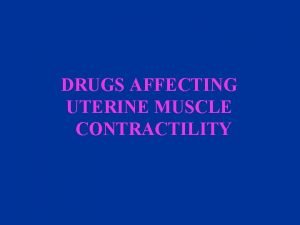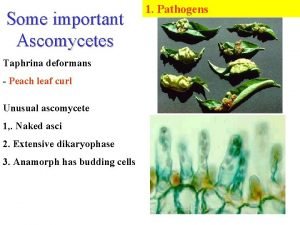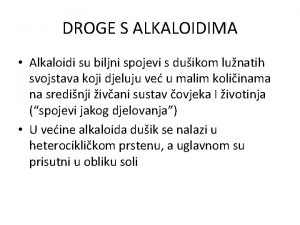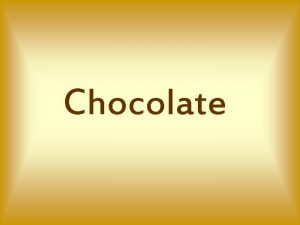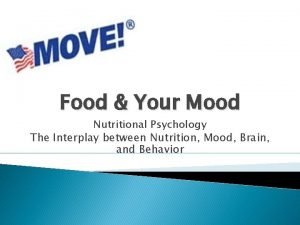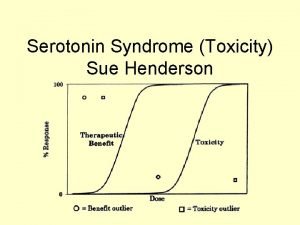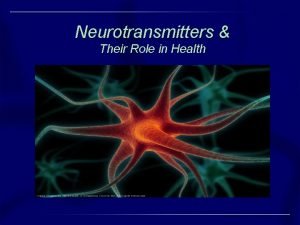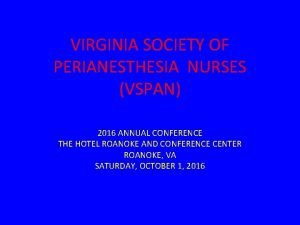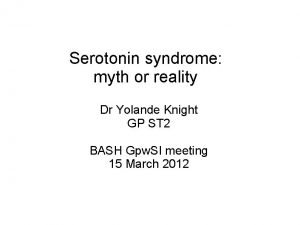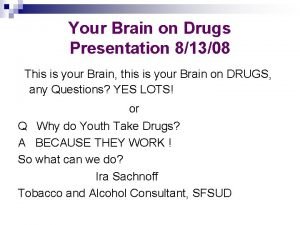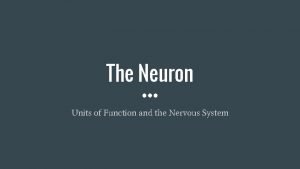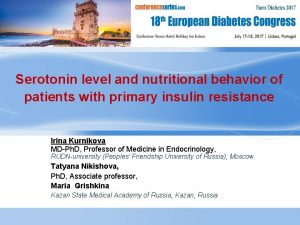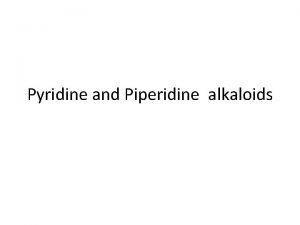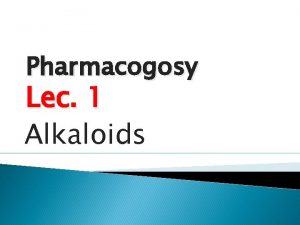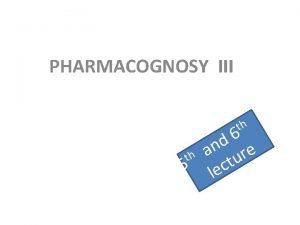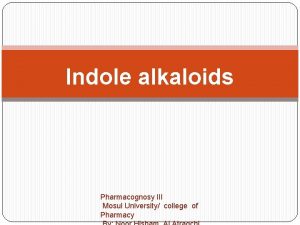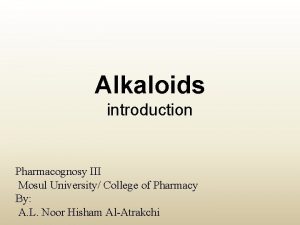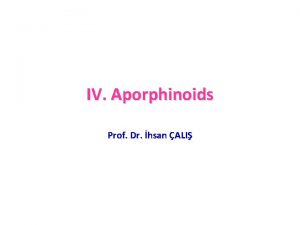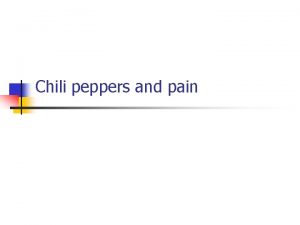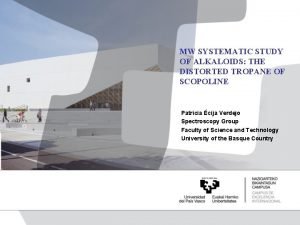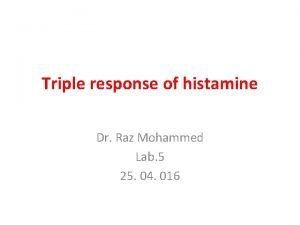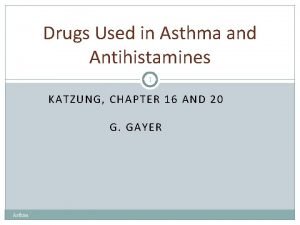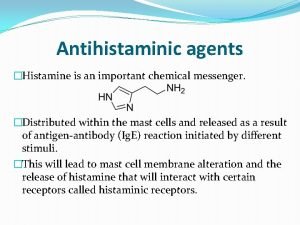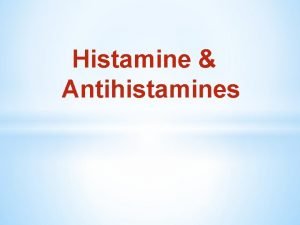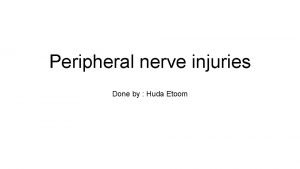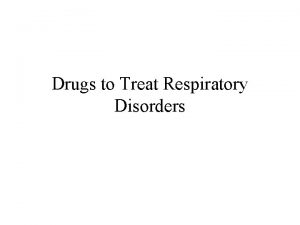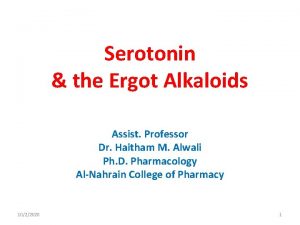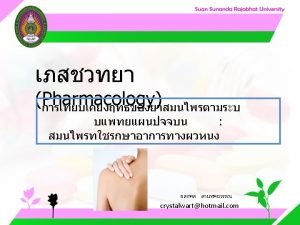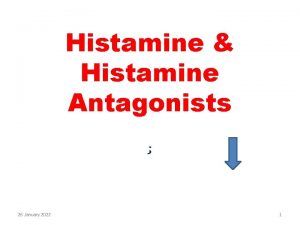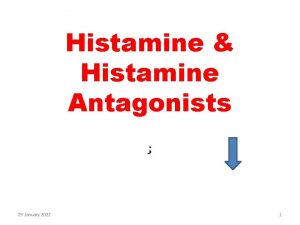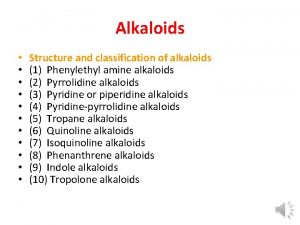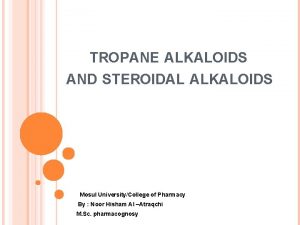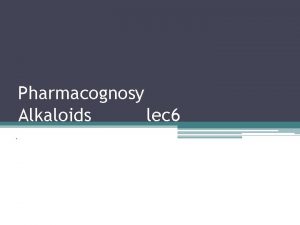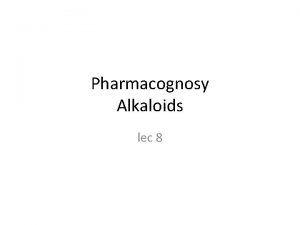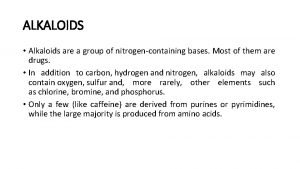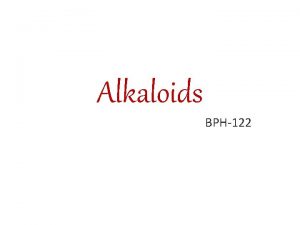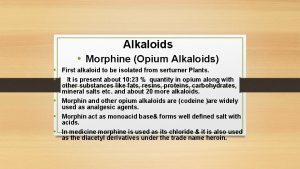Histamine Serotonin and the Ergot Alkaloids Histamine and


























































- Slides: 58

Histamine, Serotonin and the Ergot Alkaloids

Histamine and 5 -HT • Histamine and Serotonin (5 -HT) are biologically active amines that function as neurotransmitters • They are often used in non-neural tissues

The Autocoids • Histamine, serotonin and endogenous peptides, prostaglandins, leukotrienes, and cytokines are called autocoids, meaning “selfremedy” in Greek

Histamine • Histamine is an important mediator of immediate allergic and inflammatory reactions • Histamine also plays an important role in gastric acid secretions

Histamine • Histamine also functions as a neurotransmitter and neuromodulator • Histamine also plays an important role in chemotaxis of white blood cells

Histamine • Histamine is formed from the amino acid histadine • Immunologic processes account for the most important pathophysiologic mechanism of mast cell and basophil histamine release

Histamine • Histamine and mast cells release histamine explosively when antigens come in contact with the cells Ig. E antibodies • This degranulation of the mast cells and basophils require calcium and energy

Histamine • Histamine is also released by damaged tissues • Histamine causes vasodilation and capillary leakage, allowing plasma immune mediators to enter the area

Histamine Pharmacodynamics • Histamine activates specific cellular receptors on surface membranes • We know of 4 types of histamine receptors

Histamine Pharmacodynamics • H 1 receptors are found on smooth muscle and endothelium • H 2 are found on gastric mucosa

Histamine Pharmacodynamics • H 3 receptors are found in nerves in the gut responsible for peristalsis • H 4 receptors are found on white blood cells


Histamine Neural Action • Histamine is a powerful stimulant of sensory nerve endings, especially those that mediate pain and itching

Histamine Vascular Action • Histamine causes vasodilation and lowers blood pressure

Histamine Bronchiole Action • Histamine causes bronchoconstriction because of bronchial smooth muscle constriction • People with asthma are especially sensitive to histamine

Histamine Gut Action • Histamine causes contraction of intestinal smooth muscle

Histamine Stomach Acid Secretion • Histamine causes secretion of stomach acid

Histamine Scombroid Poisoning • Scombroid fish poisoning (scombrotoxism, scromboid ichthyotoxicosis) is a food-related illness typically associated with the consumption of fish • Originally the illness was associated with scombroidea fish (e. g. large dark meat marine tuna, albacore, mackerel), however, we have identified the largest vector to be nonscombroid fish, such as mahi-mahi and amberjack

Histamine Scombroid Poisoning • The principal agent in scombroid poisoning is histamine, along with other biologically active amines

Histamine Scombroid Poisoning • Scombroid toxicity is usually self-limited but may cause significant discomfort. The onset of symptoms is usually 10 -30 minutes after ingestion of the implicated fish, which is said to have a characteristic peppery bitter taste. The symptoms are nonspecific and may include the following:

Histamine Scombroid Poisoning • • • Flushing Palpitations Headache Diarrhea Sense of anxiety or unease Prostration (complete physical or mental exhaustion) Loss of vision (rare) Diffuse, macular blanching erythema (most common) Tachycardia Wheezing (generally only in histamine-sensitive asthmatics) Hypotension or hypertension


Histamine Pharmacology • Histamine is used clinically as a provocative test in pulmonary function tests • It has no clinical use otherwise

Histamine Antagonism • Histamine actions are the opposite effect of epinephrine, although different receptors and physiologic processes are involved • Epinephrine is the physiologic antagonist of histamine

Histamine Antagonists • Several histamine receptor antagonists or “blockers” have clinical usefullness • H 1 Antagonists – “Antihistamines” • H 2 Antagonists – “H 2 Blockers”

Antihistamines H 1 Antagonists • Antihistamines exert their “antiallergy” properties by antagonizing histamine at the H 1 receptor • However, many of the actions of antihistamines have nothing to do with H 1 receptor blockade

Antihistamines H 1 Antagonists • • • Sedation Anxiolytic effect Antinausea and motion sickness Antiparkinsonian effect Anticholinergic effect – None of these effects are due to H 1 antagonism

Antihistamines H 1 Antagonists • Serotonin Blockade • Adrenergic Blockade – None of these effects are due to H 1 antagonism

Antihistamines H 1 Antagonists • Diphenhydramine (Benadryl) – Antiallergy – Antiparkinsonian – Sedative

Antihistamines H 1 Antagonists • Hydroxyzine (Atarax) – Antipruritic – Anxiolytic

Antihistamines H 1 Antagonists • Meclizine (Bonine) – Motion sickness – Vertigo

Antihistamines H 1 Antagonists • Cyproheptadine (Periactin) • H 1 antagonist that also prevent serotonin production – Indicated for allergy – Indicated for serotonin syndrome

Antihistamines H 1 Antagonist • Newer generation H 1 blockers have a more selective effect on H 1 blockade - fexofenadine (Allegra) - Loratadine (Claritin) - Ceririzine (Zyrtec)


H 2 Blockers • H 2 histamine receptor antagonists are used to prevent excess stomach acid – Cimetidine (Tagamet) – Famotidine (Pepcid) – Nizatidine (Axid) – Ranitidine (Zantac)

Serotonin 5 -Hydroxytryptophan (5 -HT) • It has been known that when blood is allowed to clot, a vasoconstrictive substance is released from the clot • This substance was called “serotonin”

Serotonin (5 -HT) • This substance was later found to have many other properties • Serotonin is an important neurotransmitter, a local hormone in the gut, and is involved in migraine headaches

Serotonin (5 -HT) • Serotonin is synthesized from the amino acid tryptophan • 5 -HT is metabolized to 5 -HIAA (5 hydroxyindoleacetic acid) by monoamine oxidase (MAO)

Carcinoid • About 10% of carcinoid tumors secrete excessive serotonin (5 -HT) – Flushing – Diarrhea – Wheezing – Abdominal cramping – Peripheral edema

5 -HIAA • Carcinoid tumors can secrete excessive amounts of serotonin • 24 -hour urine secretion of 5 -HIAA is a diagnostic test for carcinoid tumors

Serotonin (5 -HT) • There are many serotonin receptor subtypes mostly in the brain • There are subtypes of serotonin receptors in the gut, smooth muscle, and platelets as well

Serotonin (5 -HT) • Serotonin has no clinical application as a drug • But many serotonin agonists and antagonists have extensive clinical value

Serotonin (5 -HT) Agonist • Buspirone (Buspar) is a 5 -HT 1 A agonist • - nonbenzodiazepine anxiolytic

Serotonin (5 -HT) Agonists • Sumatriptan (Immitrex) is a 5 -HT 1 D/1 B agonist • - migraine headache

Serotonin (5 -HT) Agonists • There are many “triptans” on the market for migraine headaches - sumatriptan (Immitrex) - Naratriptan (Amerge) - Almotriptan (Axert) - Zolmitriptan (Zomig) - Nizatriptan (Maxalt) - Eletriptan (Relpax)

Serotonin (5 -HT) • SSRI are commonly prescribed for depression, anxiety, and obsessive compulsive disorders

Serotonin (5 -HT) • • • There are many SSRI’s in the market - fluoxetine (Prozac) - sertraline (Zoloft) - paroxetine (Paxil) - citalopram (Celexa) - escitalopram (Lexapro)

Serotonin (5 -HT) Antagonists • Ondansetron (Zofran) is a 5 -HT antagonist used for nausea and vomiting of cancer chemotherapy

Serotonin Syndrome • Is a potentially fatal complication of excess synaptic serotonin by the use of one or more serotonin increasing drugs such as: • - SSRI • - MAOi • - the migraine “triptans” • - ondasetron (Zofran)

Serotonin Syndrome • • • Presents clinically as: - Hypertension - hyperreflexia - tremor - hyperthermia - diarrhea - mydriasis - agitation - coma

Serotonin Syndrome • Serotonin syndrome is treated with: • - benzodiazepines – Diazepam (Valium) – crproheptadine (Periactin) • An antihistamine that blocks serotonin production

The Ergot Alkaloids • Are produced by a fungus that infects grains. This fungus claviceps purpurea, synthesizes histamine, acetylcholine, tyramine, and other biologically active products, in addition to a wide range of ergot alkaloids

Ergot Alkaloids • These ergot alkaloids affect alpha adrenoreceptors, dopamine receptors, and serotonin receptors

Ergot Alkaloids • Accidental ingestion of ergot alkaloids from moldy grain can be traced back over 2000 years • Ergotism

Ergot Alkaloids • The most dramatic effect being dementia, hallucinations, prolonged vasospasm, gangrene, and spontaneous abortion, one can imagine the social chaos and accusations of witchcraft and satanism associated with outbreaks of ergotism

Ergot Alkaloids • But now we know that certain naturally occuring ergot alkaloids have hallucinatory properties • LSD (lysergic acid diethylamide) is a synthetic ergot alkaloid with 5 -HT 2 properties

Ergot Alkaloids • Bromocriptine is an ergot alkaloid with an agonist effect on dopamine receptors • Bromocriptine (Parlodel) is used to treat Parkinson’s disease and treat pituitary adenomas that secrete prolactin

Ergot Alkaloids • Ergotamine (Cafergot) is especially effective for migraine headache during the prodrome or “aura” phase
 Lysergic acid hydroxyethylamide
Lysergic acid hydroxyethylamide Ergot alkaloids alpha blockers
Ergot alkaloids alpha blockers Ergot alkaloids alpha blockers
Ergot alkaloids alpha blockers Ascomycetes diagram
Ascomycetes diagram Otrovan biljni alkaloid
Otrovan biljni alkaloid Smut of bajra
Smut of bajra Serotonin and chocolate
Serotonin and chocolate Dopamine and serotonin pathways
Dopamine and serotonin pathways Serotonin definition
Serotonin definition Serotonin deficiency
Serotonin deficiency Glycine serotonin
Glycine serotonin Serotonin syndrome mnemonic shivers
Serotonin syndrome mnemonic shivers Yolande knight
Yolande knight Plusmama.ru/analysis/serotonin-v-krovi
Plusmama.ru/analysis/serotonin-v-krovi Serotonin vs dopamine
Serotonin vs dopamine Serotonin function
Serotonin function Serotonin
Serotonin Serotonin obesity
Serotonin obesity Pyridine piperidine alkaloids
Pyridine piperidine alkaloids Norlupinane
Norlupinane Norlupinane
Norlupinane Uses of alkaloids in pharmacognosy
Uses of alkaloids in pharmacognosy Biological importance of alkaloids
Biological importance of alkaloids Uses of alkaloids in pharmacognosy
Uses of alkaloids in pharmacognosy Lophophora
Lophophora Purine alkaloids
Purine alkaloids Purine alkaloids
Purine alkaloids Peomus
Peomus Purine examples
Purine examples Belladonna alkaloids drugs
Belladonna alkaloids drugs Tropane alkaloids
Tropane alkaloids Triple response histamine
Triple response histamine Phosphodiesterase inhibitors
Phosphodiesterase inhibitors Antinausia
Antinausia Histamine
Histamine Histamine test brachial plexus
Histamine test brachial plexus Histamine function
Histamine function Hát kết hợp bộ gõ cơ thể
Hát kết hợp bộ gõ cơ thể Bổ thể
Bổ thể Tỉ lệ cơ thể trẻ em
Tỉ lệ cơ thể trẻ em Chó sói
Chó sói Glasgow thang điểm
Glasgow thang điểm Chúa yêu trần thế
Chúa yêu trần thế Các môn thể thao bắt đầu bằng từ đua
Các môn thể thao bắt đầu bằng từ đua Thế nào là hệ số cao nhất
Thế nào là hệ số cao nhất Các châu lục và đại dương trên thế giới
Các châu lục và đại dương trên thế giới Cong thức tính động năng
Cong thức tính động năng Trời xanh đây là của chúng ta thể thơ
Trời xanh đây là của chúng ta thể thơ Mật thư anh em như thể tay chân
Mật thư anh em như thể tay chân Phép trừ bù
Phép trừ bù Phản ứng thế ankan
Phản ứng thế ankan Các châu lục và đại dương trên thế giới
Các châu lục và đại dương trên thế giới Thể thơ truyền thống
Thể thơ truyền thống Quá trình desamine hóa có thể tạo ra
Quá trình desamine hóa có thể tạo ra Một số thể thơ truyền thống
Một số thể thơ truyền thống Cái miệng nó xinh thế chỉ nói điều hay thôi
Cái miệng nó xinh thế chỉ nói điều hay thôi Vẽ hình chiếu vuông góc của vật thể sau
Vẽ hình chiếu vuông góc của vật thể sau Nguyên nhân của sự mỏi cơ sinh 8
Nguyên nhân của sự mỏi cơ sinh 8


